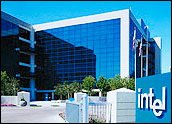
Fierce price competition in the computer chip sector caused market leader Intel to see far lower profits in the fourth quarter, even though sales were up strongly.
Intel said Wednesday that revenue for the quarter was US$9.7 billion, 5 percent below the same quarter a year ago but up 11 percent from the third quarter.
Net income was $1.5 billion, down 39 percent year-over-year. Earnings per share came in at 26 cents, narrowly edging consensus forecasts from Wall Street analysts.
Profits Under Pressure
“Intel’s product and technology leadership yielded a strong fourth quarter with higher selling prices and record unit shipments in the fastest growing segments of the market,” said CEO Paul Otellini.
Nonetheless, Intel said profits may continue to be under pressure going forward. Gross profit margin will be around 49 percent in the first quarter and in the 50 percent range for all of 2007, the company said. That figure has been as high as 62 percent and is regularly above 55 percent during strong times for Intel.
Intel did not say whether price cuts would continue, but CFO Andy Bryant suggested in a conference call Wednesday that the company was ready to do what it takes to win and retain customers. “We’re going to have to fight to win orders,” he said.
Intel shares were down more than 5 percent in morning trading Wednesday following the report, to $21.13.
Intel’s results mirrored those of its smaller rival, Advanced Micro Devices (AMD), which last week said it shipped more processors than ever but saw profits hurt by competition from Intel. Intel has fought hard to regain market share that AMD had wrestled away in recent quarters.
Profits or Sales?
During the conference call, Otellini said he would continue to oversee a strategy that relied heavily on investing in next-generation chip designs, new plants and other capital efforts.
In the long run, that will help Intel retain its market share and win new customers even though the approach may shave profits in the near-term.
“I continue to believe that our shareholders are best served by Intel using its capacity to retake market share that we lost this year,” he said.
Intel executives also said they were not banking on a sales surge tied to any business upgrade cycle spurred on by the release of Windows Vista.
Though the next generation of Microsoft’s dominant operating system will be available in coming weeks, consumers are likely to adopt first, with business users — who could spur significant demand for new chips if they upgrade computers to handle — taking a more measured approach and phasing in Vista use over time, Otellini noted.
Intel boosted the average selling price of its chips, thanks in part to demand for high-end equipment such as chip sets that run large servers.
Though overall sales of microprocessors and memory chips remain robust and continue to grow at a double-digit clip, much of that growth is tied to mobile devices and consumer electronics rather than PC processors.
In fact, market research firm iSuppli said PC-specific chip sales were down more than 6 percent in 2006, to $31.9 billion.
Fighting Back
Intel has said it wants to be more of a player in the market for non-PC chips, developing gear to operate wireless home entertainment networks, for instance.
In addition, the company has been refocusing on its core business recently, selling off a line of mobile communications chips during the second half of 2006. In an aggressive restructuring effort, Intel reduced its workforce to 94,100 at the end of 2006, compared to 102,500 a year ago.
The company has seen its enormous market-share advantage eroded to the point where it needs to rework its business processes to reflect a new reality, one in which AMD has considerable market share, Prudential analyst Mark Lipacis said in a research note.
“We expect the industry to transition to a true duopoly whose natural equilibrium is something closer to 50 percent share for both companies,” compared to the one-time near-monopoly enjoyed by Intel, Lipacis wrote.
While Intel tried to put a positive spin on the results by focusing on unit shipments, “ultimately, it’s profit margins that excite tech investors,” said independent stock analyst Don Harrold. “For prices to move higher — or for profits to rise substantially — Intel will need to roll out products that beat the competition without a need to cut prices.”
AMD caught Intel off guard but Intel is now focused on winning back market share and seems to understand that the best way to do that is to build faster, more efficient and more capable products, said Gartner analyst Martin Reynolds.
“Price cutting is a short-term solution,” he said. “In the end, innovation will be the deciding factor.”























































Social Media
See all Social Media